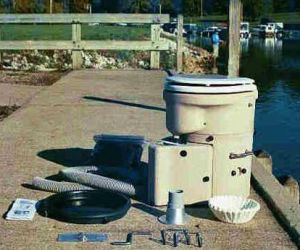 My solution to the problems, concerns and mandates about marine toilets had been to use a Porta-Potti and a few jury-rig devices that satisfy federal “no discharge” requirements. It was not an ideal solution. The thought of drilling two (2) holes in my hull and one hole in my deck to install a standard marine head and then carrying around a tank full of waste for an indeterminate time until I was either offshore or found a working pumpout station, just did not fit my concept of prudent seamanship. Better technology in the form of a composting toilet showed up at the 2002 Miami Boat Show.
My solution to the problems, concerns and mandates about marine toilets had been to use a Porta-Potti and a few jury-rig devices that satisfy federal “no discharge” requirements. It was not an ideal solution. The thought of drilling two (2) holes in my hull and one hole in my deck to install a standard marine head and then carrying around a tank full of waste for an indeterminate time until I was either offshore or found a working pumpout station, just did not fit my concept of prudent seamanship. Better technology in the form of a composting toilet showed up at the 2002 Miami Boat Show.
Composting toilets are not new. The technology is tried and true, proven over many decades of use in areas where either public sewerage is not available or sanitary septic systems are not feasible. My 32 foot catamaran fits into the greater spectrum of smaller yachts with installed marine toilets, thus it appeared a better than average solution if it worked as stated by the developer. The Air Head Composting Toilet is the brainchild of Geoffrey Trott, and has been around for a couple of years getting well tested. I installed one in my own boat based upon my own intuition, the assurances of the designer and the reports from other users.
Competing composting toilet units are essentially too large for a small to medium sized boat, but my Air Head unit has the same footprint as my diminutive Porta-Potti, though it is almost twice as tall. Next, it is simplicity itself, having few moving parts and only a 45 milliamp muffin fan as current draw, it uses no water, thus has no seacocks or hoses. Third, it is of modest cost. Specifications are three hundred dollars less than a complex marine toilet installation with seacocks, “Y” valves, siphon breaks, holding tanks, yards of costly pipe, macerator pumps and deck pump out connections. The only thing the two systems have in common is the vent pipe.
There are the usual concerns about odors. Based on the reports of others and my own intuition, I figured that the odors could not possibly be greater than many of the liquid based system I have surveyed, which was my initial reluctance to have such a system in my boat in the first place. The Air Head is USCG approved under CFR 159.53.
The unit bolts to the cabin sole with spring loaded catches. I decided to use an unobtrusive side mount under the rubrail for the vent exit in lieu of a deck mounted solar vent. The unit needs only the supplied initial feeding of ordinary peat-moss, replaceable at any garden shop and a modest amount of electric power for the fan that maintains airflow. After using the unit, a couple of turns of the crank handle mixes the material with the peat moss and natural decomposition takes place, thus returning it to its original state, which is plain soil! Simply put, similar to the way a cat buries it. However, the reason the unit is able to be so small and simple is the method of separating liquids from the solids.
 Urine is separated into a quick-detach bottle. A teaspoon full of ordinary sugar in the bottle suppresses odor. The bottle is convenient to empty. Disposing of urine is seldom if ever a problem, especially considering it is usually considered sterile and has no nutrient value. The operating capacity of the unit is based upon approximately two uses per day for two people or 80 uses. To empty, the bottom unit is detached and the material either appropriately dumped or stored until completely degraded, then placed in the flower beds. Any bacterial or viral contamination is destroyed by the natural processes. In our own case, it will most likely be several years before we need to empty it, based upon our own lifestyle which considers offshore and marina supplements.
Urine is separated into a quick-detach bottle. A teaspoon full of ordinary sugar in the bottle suppresses odor. The bottle is convenient to empty. Disposing of urine is seldom if ever a problem, especially considering it is usually considered sterile and has no nutrient value. The operating capacity of the unit is based upon approximately two uses per day for two people or 80 uses. To empty, the bottom unit is detached and the material either appropriately dumped or stored until completely degraded, then placed in the flower beds. Any bacterial or viral contamination is destroyed by the natural processes. In our own case, it will most likely be several years before we need to empty it, based upon our own lifestyle which considers offshore and marina supplements.
Stay tuned, we will keep you posted.
For full details, check website: www.airheadtoilet.com or write:
EOS Design LLC, AIR HEAD Dry Toilet
Geoffry Trott
P.O. Box 5, Mount Vernon, OH 43050
740 392-3642, 866 556-1571, Fax: 707 371-3829, Cell: 740 358-1022






